Exploring Professional Ethics in Civil Engineering Through the ASCE
VerifiedAdded on 2023/06/04
|6
|1583
|59
Essay
AI Summary
This essay provides an analysis of the American Society of Civil Engineers (ASCE) as a professional association, focusing on its role in promoting and upholding professional ethics within the field of civil engineering. It discusses the history and background of the ASCE, its advocacy efforts in shaping legislation and funding for infrastructure and STEM programs, and a personal reflection on the ASCE's code of professionalism. The essay also addresses a case of overlapping reports between the ASCE and the United States Army Corps of Engineers (USACE) following Hurricane Katrina, highlighting potential issues of professionalism. The conclusion emphasizes the importance of adhering to professional ethics, prioritizing morality, and using conflict resolution mechanisms to enhance the profession.
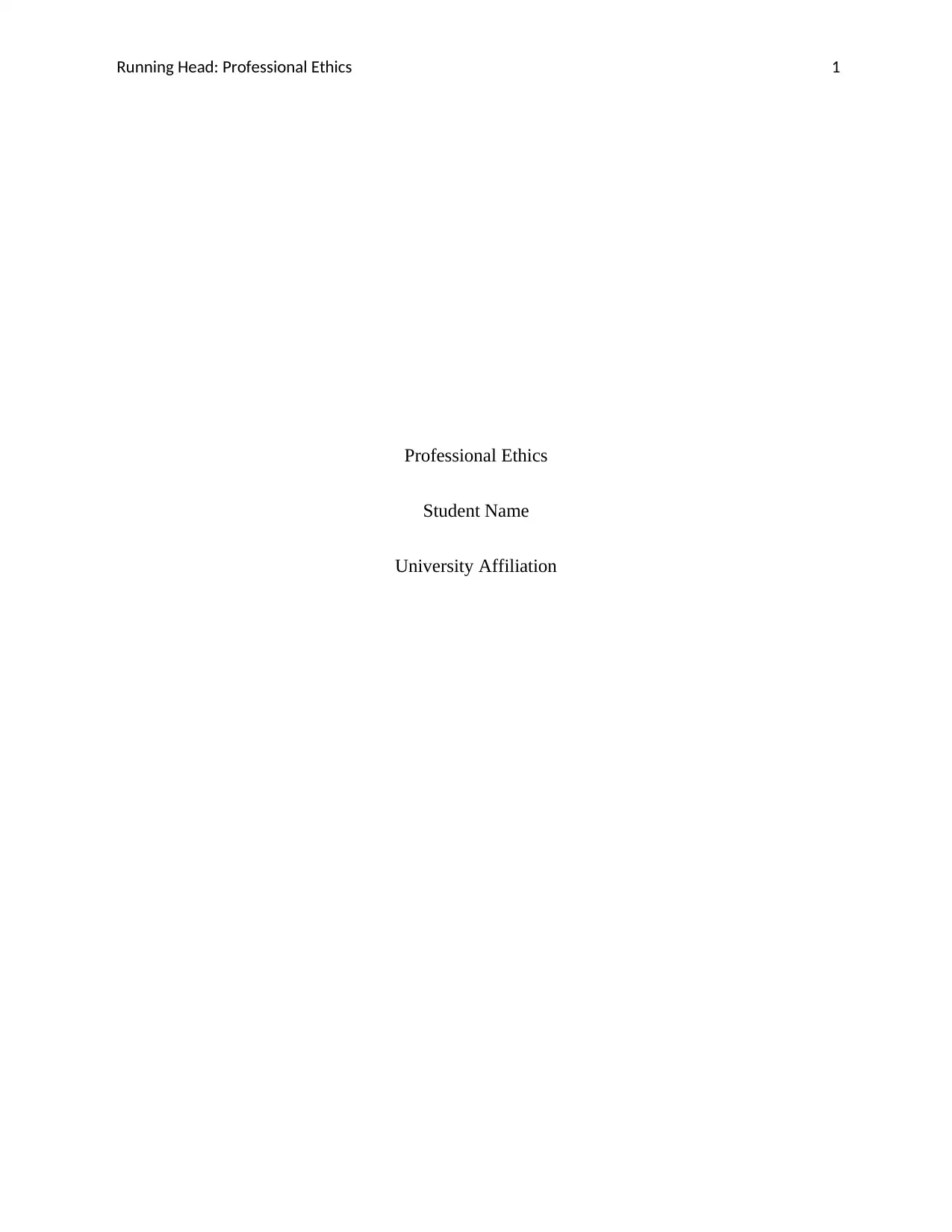
Running Head: Professional Ethics 1
Professional Ethics
Student Name
University Affiliation
Professional Ethics
Student Name
University Affiliation
Paraphrase This Document
Need a fresh take? Get an instant paraphrase of this document with our AI Paraphraser
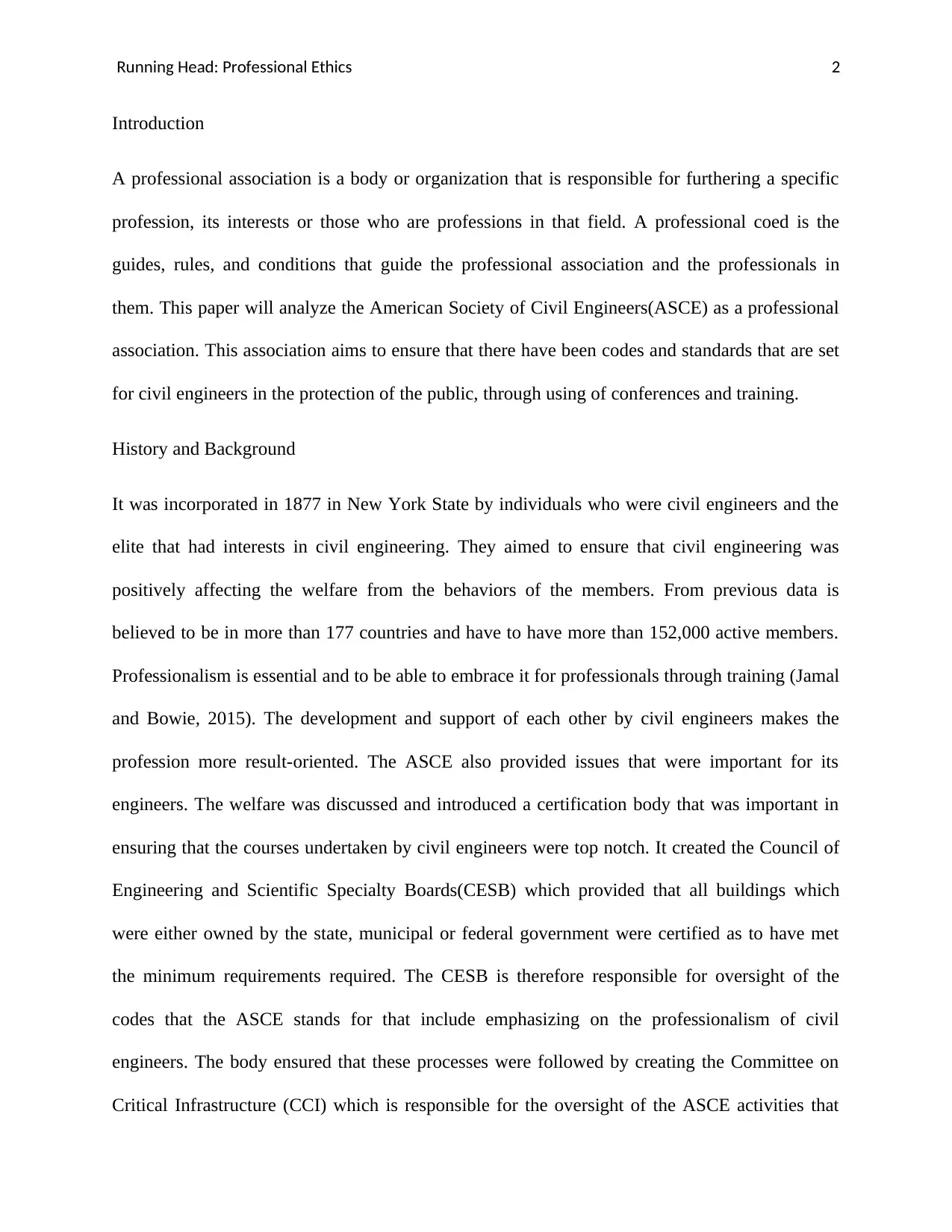
Running Head: Professional Ethics 2
Introduction
A professional association is a body or organization that is responsible for furthering a specific
profession, its interests or those who are professions in that field. A professional coed is the
guides, rules, and conditions that guide the professional association and the professionals in
them. This paper will analyze the American Society of Civil Engineers(ASCE) as a professional
association. This association aims to ensure that there have been codes and standards that are set
for civil engineers in the protection of the public, through using of conferences and training.
History and Background
It was incorporated in 1877 in New York State by individuals who were civil engineers and the
elite that had interests in civil engineering. They aimed to ensure that civil engineering was
positively affecting the welfare from the behaviors of the members. From previous data is
believed to be in more than 177 countries and have to have more than 152,000 active members.
Professionalism is essential and to be able to embrace it for professionals through training (Jamal
and Bowie, 2015). The development and support of each other by civil engineers makes the
profession more result-oriented. The ASCE also provided issues that were important for its
engineers. The welfare was discussed and introduced a certification body that was important in
ensuring that the courses undertaken by civil engineers were top notch. It created the Council of
Engineering and Scientific Specialty Boards(CESB) which provided that all buildings which
were either owned by the state, municipal or federal government were certified as to have met
the minimum requirements required. The CESB is therefore responsible for oversight of the
codes that the ASCE stands for that include emphasizing on the professionalism of civil
engineers. The body ensured that these processes were followed by creating the Committee on
Critical Infrastructure (CCI) which is responsible for the oversight of the ASCE activities that
Introduction
A professional association is a body or organization that is responsible for furthering a specific
profession, its interests or those who are professions in that field. A professional coed is the
guides, rules, and conditions that guide the professional association and the professionals in
them. This paper will analyze the American Society of Civil Engineers(ASCE) as a professional
association. This association aims to ensure that there have been codes and standards that are set
for civil engineers in the protection of the public, through using of conferences and training.
History and Background
It was incorporated in 1877 in New York State by individuals who were civil engineers and the
elite that had interests in civil engineering. They aimed to ensure that civil engineering was
positively affecting the welfare from the behaviors of the members. From previous data is
believed to be in more than 177 countries and have to have more than 152,000 active members.
Professionalism is essential and to be able to embrace it for professionals through training (Jamal
and Bowie, 2015). The development and support of each other by civil engineers makes the
profession more result-oriented. The ASCE also provided issues that were important for its
engineers. The welfare was discussed and introduced a certification body that was important in
ensuring that the courses undertaken by civil engineers were top notch. It created the Council of
Engineering and Scientific Specialty Boards(CESB) which provided that all buildings which
were either owned by the state, municipal or federal government were certified as to have met
the minimum requirements required. The CESB is therefore responsible for oversight of the
codes that the ASCE stands for that include emphasizing on the professionalism of civil
engineers. The body ensured that these processes were followed by creating the Committee on
Critical Infrastructure (CCI) which is responsible for the oversight of the ASCE activities that
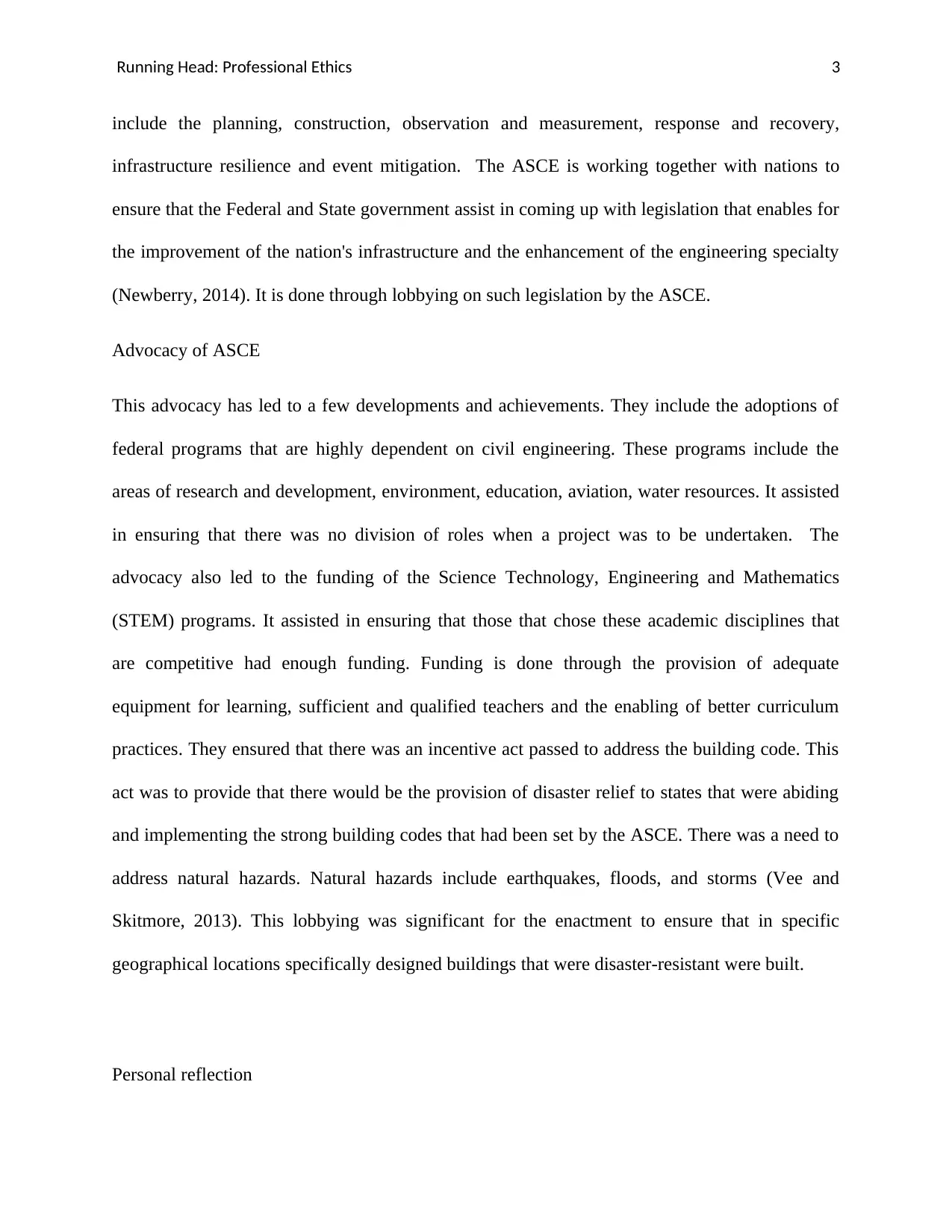
Running Head: Professional Ethics 3
include the planning, construction, observation and measurement, response and recovery,
infrastructure resilience and event mitigation. The ASCE is working together with nations to
ensure that the Federal and State government assist in coming up with legislation that enables for
the improvement of the nation's infrastructure and the enhancement of the engineering specialty
(Newberry, 2014). It is done through lobbying on such legislation by the ASCE.
Advocacy of ASCE
This advocacy has led to a few developments and achievements. They include the adoptions of
federal programs that are highly dependent on civil engineering. These programs include the
areas of research and development, environment, education, aviation, water resources. It assisted
in ensuring that there was no division of roles when a project was to be undertaken. The
advocacy also led to the funding of the Science Technology, Engineering and Mathematics
(STEM) programs. It assisted in ensuring that those that chose these academic disciplines that
are competitive had enough funding. Funding is done through the provision of adequate
equipment for learning, sufficient and qualified teachers and the enabling of better curriculum
practices. They ensured that there was an incentive act passed to address the building code. This
act was to provide that there would be the provision of disaster relief to states that were abiding
and implementing the strong building codes that had been set by the ASCE. There was a need to
address natural hazards. Natural hazards include earthquakes, floods, and storms (Vee and
Skitmore, 2013). This lobbying was significant for the enactment to ensure that in specific
geographical locations specifically designed buildings that were disaster-resistant were built.
Personal reflection
include the planning, construction, observation and measurement, response and recovery,
infrastructure resilience and event mitigation. The ASCE is working together with nations to
ensure that the Federal and State government assist in coming up with legislation that enables for
the improvement of the nation's infrastructure and the enhancement of the engineering specialty
(Newberry, 2014). It is done through lobbying on such legislation by the ASCE.
Advocacy of ASCE
This advocacy has led to a few developments and achievements. They include the adoptions of
federal programs that are highly dependent on civil engineering. These programs include the
areas of research and development, environment, education, aviation, water resources. It assisted
in ensuring that there was no division of roles when a project was to be undertaken. The
advocacy also led to the funding of the Science Technology, Engineering and Mathematics
(STEM) programs. It assisted in ensuring that those that chose these academic disciplines that
are competitive had enough funding. Funding is done through the provision of adequate
equipment for learning, sufficient and qualified teachers and the enabling of better curriculum
practices. They ensured that there was an incentive act passed to address the building code. This
act was to provide that there would be the provision of disaster relief to states that were abiding
and implementing the strong building codes that had been set by the ASCE. There was a need to
address natural hazards. Natural hazards include earthquakes, floods, and storms (Vee and
Skitmore, 2013). This lobbying was significant for the enactment to ensure that in specific
geographical locations specifically designed buildings that were disaster-resistant were built.
Personal reflection
⊘ This is a preview!⊘
Do you want full access?
Subscribe today to unlock all pages.

Trusted by 1+ million students worldwide
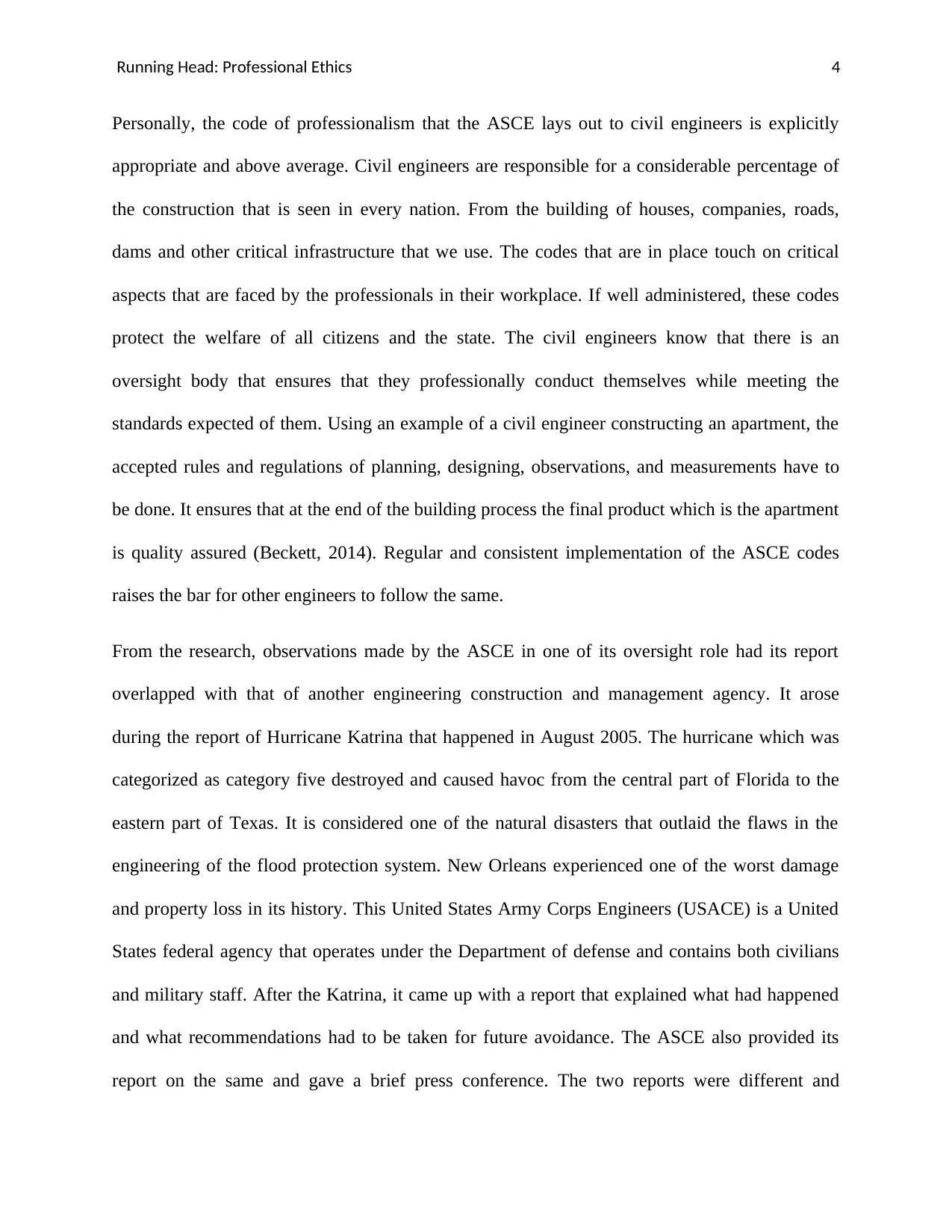
Running Head: Professional Ethics 4
Personally, the code of professionalism that the ASCE lays out to civil engineers is explicitly
appropriate and above average. Civil engineers are responsible for a considerable percentage of
the construction that is seen in every nation. From the building of houses, companies, roads,
dams and other critical infrastructure that we use. The codes that are in place touch on critical
aspects that are faced by the professionals in their workplace. If well administered, these codes
protect the welfare of all citizens and the state. The civil engineers know that there is an
oversight body that ensures that they professionally conduct themselves while meeting the
standards expected of them. Using an example of a civil engineer constructing an apartment, the
accepted rules and regulations of planning, designing, observations, and measurements have to
be done. It ensures that at the end of the building process the final product which is the apartment
is quality assured (Beckett, 2014). Regular and consistent implementation of the ASCE codes
raises the bar for other engineers to follow the same.
From the research, observations made by the ASCE in one of its oversight role had its report
overlapped with that of another engineering construction and management agency. It arose
during the report of Hurricane Katrina that happened in August 2005. The hurricane which was
categorized as category five destroyed and caused havoc from the central part of Florida to the
eastern part of Texas. It is considered one of the natural disasters that outlaid the flaws in the
engineering of the flood protection system. New Orleans experienced one of the worst damage
and property loss in its history. This United States Army Corps Engineers (USACE) is a United
States federal agency that operates under the Department of defense and contains both civilians
and military staff. After the Katrina, it came up with a report that explained what had happened
and what recommendations had to be taken for future avoidance. The ASCE also provided its
report on the same and gave a brief press conference. The two reports were different and
Personally, the code of professionalism that the ASCE lays out to civil engineers is explicitly
appropriate and above average. Civil engineers are responsible for a considerable percentage of
the construction that is seen in every nation. From the building of houses, companies, roads,
dams and other critical infrastructure that we use. The codes that are in place touch on critical
aspects that are faced by the professionals in their workplace. If well administered, these codes
protect the welfare of all citizens and the state. The civil engineers know that there is an
oversight body that ensures that they professionally conduct themselves while meeting the
standards expected of them. Using an example of a civil engineer constructing an apartment, the
accepted rules and regulations of planning, designing, observations, and measurements have to
be done. It ensures that at the end of the building process the final product which is the apartment
is quality assured (Beckett, 2014). Regular and consistent implementation of the ASCE codes
raises the bar for other engineers to follow the same.
From the research, observations made by the ASCE in one of its oversight role had its report
overlapped with that of another engineering construction and management agency. It arose
during the report of Hurricane Katrina that happened in August 2005. The hurricane which was
categorized as category five destroyed and caused havoc from the central part of Florida to the
eastern part of Texas. It is considered one of the natural disasters that outlaid the flaws in the
engineering of the flood protection system. New Orleans experienced one of the worst damage
and property loss in its history. This United States Army Corps Engineers (USACE) is a United
States federal agency that operates under the Department of defense and contains both civilians
and military staff. After the Katrina, it came up with a report that explained what had happened
and what recommendations had to be taken for future avoidance. The ASCE also provided its
report on the same and gave a brief press conference. The two reports were different and
Paraphrase This Document
Need a fresh take? Get an instant paraphrase of this document with our AI Paraphraser
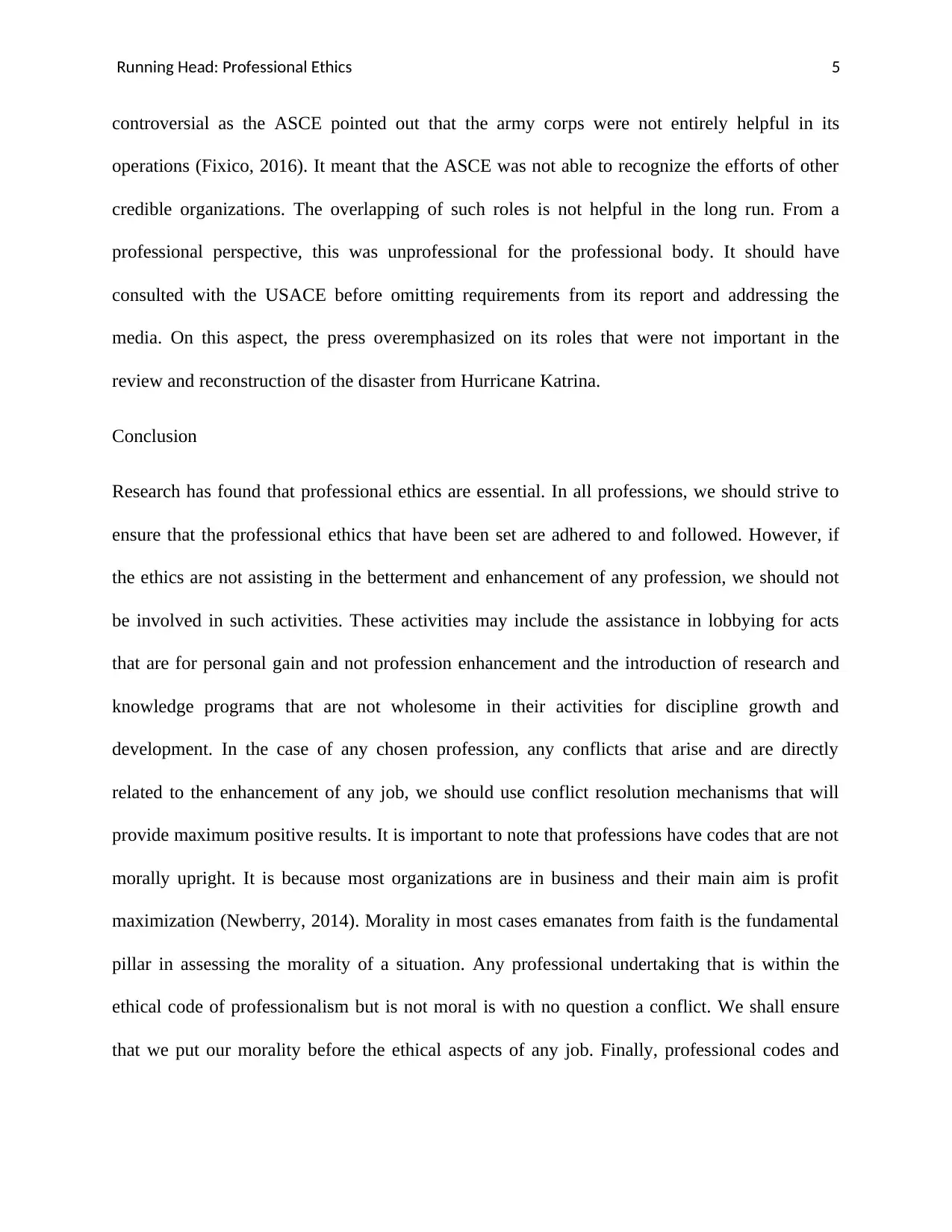
Running Head: Professional Ethics 5
controversial as the ASCE pointed out that the army corps were not entirely helpful in its
operations (Fixico, 2016). It meant that the ASCE was not able to recognize the efforts of other
credible organizations. The overlapping of such roles is not helpful in the long run. From a
professional perspective, this was unprofessional for the professional body. It should have
consulted with the USACE before omitting requirements from its report and addressing the
media. On this aspect, the press overemphasized on its roles that were not important in the
review and reconstruction of the disaster from Hurricane Katrina.
Conclusion
Research has found that professional ethics are essential. In all professions, we should strive to
ensure that the professional ethics that have been set are adhered to and followed. However, if
the ethics are not assisting in the betterment and enhancement of any profession, we should not
be involved in such activities. These activities may include the assistance in lobbying for acts
that are for personal gain and not profession enhancement and the introduction of research and
knowledge programs that are not wholesome in their activities for discipline growth and
development. In the case of any chosen profession, any conflicts that arise and are directly
related to the enhancement of any job, we should use conflict resolution mechanisms that will
provide maximum positive results. It is important to note that professions have codes that are not
morally upright. It is because most organizations are in business and their main aim is profit
maximization (Newberry, 2014). Morality in most cases emanates from faith is the fundamental
pillar in assessing the morality of a situation. Any professional undertaking that is within the
ethical code of professionalism but is not moral is with no question a conflict. We shall ensure
that we put our morality before the ethical aspects of any job. Finally, professional codes and
controversial as the ASCE pointed out that the army corps were not entirely helpful in its
operations (Fixico, 2016). It meant that the ASCE was not able to recognize the efforts of other
credible organizations. The overlapping of such roles is not helpful in the long run. From a
professional perspective, this was unprofessional for the professional body. It should have
consulted with the USACE before omitting requirements from its report and addressing the
media. On this aspect, the press overemphasized on its roles that were not important in the
review and reconstruction of the disaster from Hurricane Katrina.
Conclusion
Research has found that professional ethics are essential. In all professions, we should strive to
ensure that the professional ethics that have been set are adhered to and followed. However, if
the ethics are not assisting in the betterment and enhancement of any profession, we should not
be involved in such activities. These activities may include the assistance in lobbying for acts
that are for personal gain and not profession enhancement and the introduction of research and
knowledge programs that are not wholesome in their activities for discipline growth and
development. In the case of any chosen profession, any conflicts that arise and are directly
related to the enhancement of any job, we should use conflict resolution mechanisms that will
provide maximum positive results. It is important to note that professions have codes that are not
morally upright. It is because most organizations are in business and their main aim is profit
maximization (Newberry, 2014). Morality in most cases emanates from faith is the fundamental
pillar in assessing the morality of a situation. Any professional undertaking that is within the
ethical code of professionalism but is not moral is with no question a conflict. We shall ensure
that we put our morality before the ethical aspects of any job. Finally, professional codes and
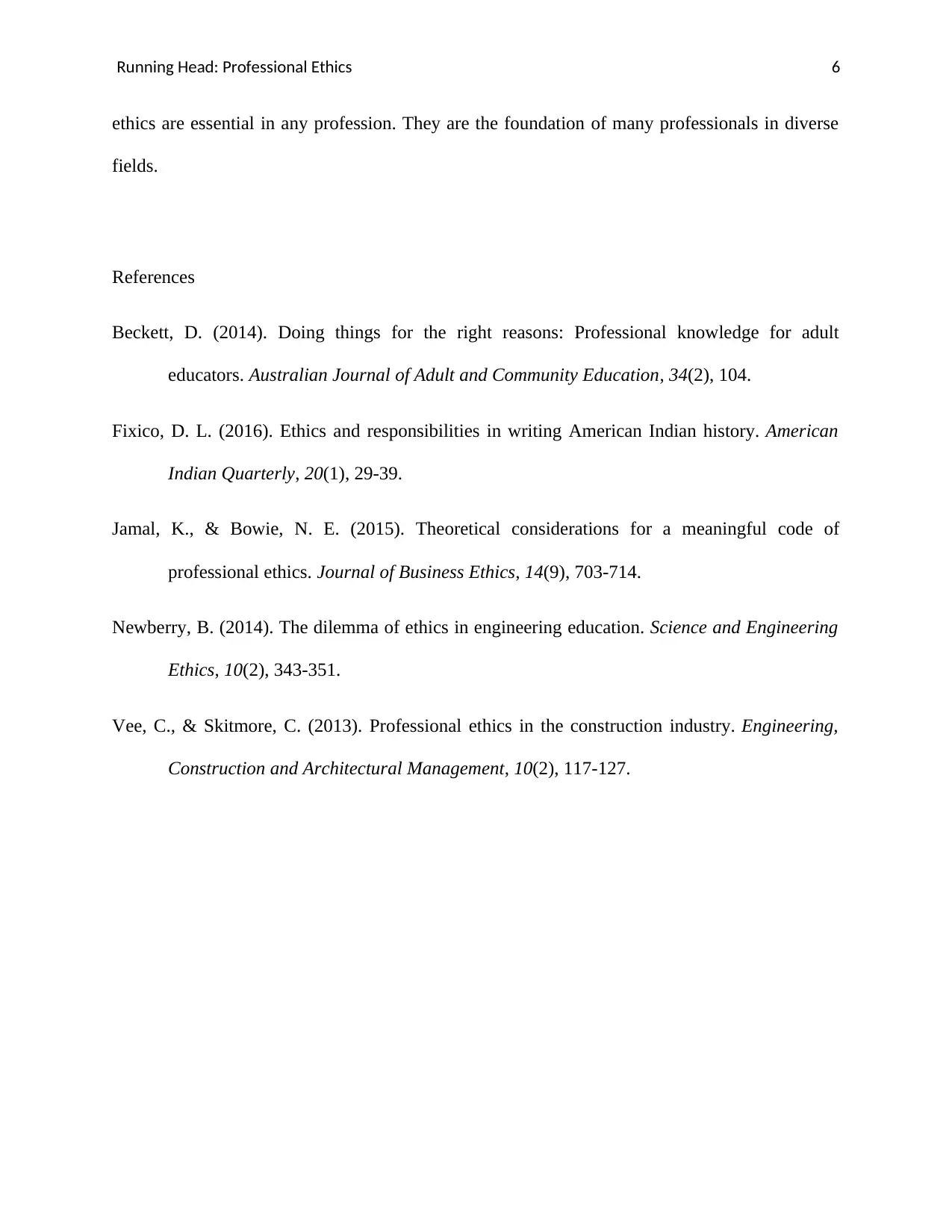
Running Head: Professional Ethics 6
ethics are essential in any profession. They are the foundation of many professionals in diverse
fields.
References
Beckett, D. (2014). Doing things for the right reasons: Professional knowledge for adult
educators. Australian Journal of Adult and Community Education, 34(2), 104.
Fixico, D. L. (2016). Ethics and responsibilities in writing American Indian history. American
Indian Quarterly, 20(1), 29-39.
Jamal, K., & Bowie, N. E. (2015). Theoretical considerations for a meaningful code of
professional ethics. Journal of Business Ethics, 14(9), 703-714.
Newberry, B. (2014). The dilemma of ethics in engineering education. Science and Engineering
Ethics, 10(2), 343-351.
Vee, C., & Skitmore, C. (2013). Professional ethics in the construction industry. Engineering,
Construction and Architectural Management, 10(2), 117-127.
ethics are essential in any profession. They are the foundation of many professionals in diverse
fields.
References
Beckett, D. (2014). Doing things for the right reasons: Professional knowledge for adult
educators. Australian Journal of Adult and Community Education, 34(2), 104.
Fixico, D. L. (2016). Ethics and responsibilities in writing American Indian history. American
Indian Quarterly, 20(1), 29-39.
Jamal, K., & Bowie, N. E. (2015). Theoretical considerations for a meaningful code of
professional ethics. Journal of Business Ethics, 14(9), 703-714.
Newberry, B. (2014). The dilemma of ethics in engineering education. Science and Engineering
Ethics, 10(2), 343-351.
Vee, C., & Skitmore, C. (2013). Professional ethics in the construction industry. Engineering,
Construction and Architectural Management, 10(2), 117-127.
⊘ This is a preview!⊘
Do you want full access?
Subscribe today to unlock all pages.

Trusted by 1+ million students worldwide
1 out of 6
Your All-in-One AI-Powered Toolkit for Academic Success.
+13062052269
info@desklib.com
Available 24*7 on WhatsApp / Email
![[object Object]](/_next/static/media/star-bottom.7253800d.svg)
Unlock your academic potential
Copyright © 2020–2025 A2Z Services. All Rights Reserved. Developed and managed by ZUCOL.